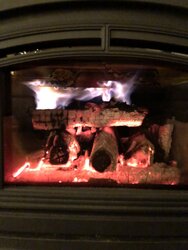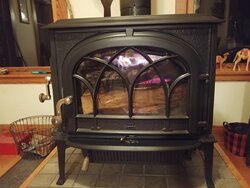I’ll have flames for a while and then I’ll close the air down a little once the insert is around 450 and I’ll have some secondaries going. If I close it down a little more after a few minutes I’ll start to lose the flame. Secondaries will stay for a little while. The logs just glow. Photo attached. Is It my wood?
Logs not staying caught
- Thread starter RIMatt
- Start date
-
Active since 1995, Hearth.com is THE place on the internet for free information and advice about wood stoves, pellet stoves and other energy saving equipment.
We strive to provide opinions, articles, discussions and history related to Hearth Products and in a more general sense, energy issues.
We promote the EFFICIENT, RESPONSIBLE, CLEAN and SAFE use of all fuels, whether renewable or fossil.
You are using an out of date browser. It may not display this or other websites correctly.
You should upgrade or use an alternative browser.
You should upgrade or use an alternative browser.
Probably partly your wood and partly that you have so little wood in there it can't sustain enough temp for secondary combustion once you shut it backI’ll have flames for a while and then I’ll close the air down a little once the insert is around 450 and I’ll have some secondaries going. If I close it down a little more after a few minutes I’ll start to lose the flame. Secondaries will stay for a little while. The logs just glow. Photo attached. Is It my wood?
PistolPeets
Member
Be careful here. If your stove is pretty air tight, you may be starving the fire of air. I've done this once and stopped the flame entirely - the wood was gassing off and when it finally lit back off, it made a boom and blew ash out of every little nook and cranny of the stove. I've since learned when to turn down the air and how much for comfort. Log placement has a lot to do with this too at least in my stove - relating to how much air gets in the firebox.
Sawset
Minister of Fire
Like the cartoons where the really steamed guy is blowing smoke out of every orifice.blew ash out of every little nook and cranny of the stove.
blacktail
Minister of Fire
^This^Probably partly your wood and partly that you have so little wood in there it can't sustain enough temp for secondary combustion once you shut it back
Rob711
Feeling the Heat
prezes13
Minister of Fire
brenndatomu
Minister of Fire
Run it up another 1-200* before beginning to close down too...450* is just barely enough...once the insert is around 450
Load it up, hes getting secondaries so the wood might be ok, just need more fuel, maybe where you had you air set is a good spot, not all stoves are turned down all the way to operate optimally under the current conditions
frarmar
Member
What I’ve learned with my insert is to be more patient with each change to air. If I’m not, it’ll seem to want to die out. I’m still new to this so take it for what it’s worth.
Yep, the wood. If I run "lincoln log" style like that with anything but kindling, then watch out, it takes off.
mar13
Minister of Fire
Probably partly your wood and partly that you have so little wood in there it can't sustain enough temp for secondary combustion once you shut it back
This makes me second guess the popular argument of "small fire in a big fire box" approach to oversized stoves if it's not just a quick "air-set- to-high" burn. I can sometimes experience something like this with 16%mc wood, especially if it's only been charred and not to coals yet (one mistake, I suppose).
Probably partly your wood and partly that you have so little wood in there it can't sustain enough temp for secondary combustion once you shut it back
I haven't run my SIL's PE T5 too much yet, as she's just been burning partial loads so far. The secondary can kick in at 350-400 stove top, and last for a while on a similar amount of wood. I have a good spot on the stove top for a meter..right in front of the top flue exit.Run it up another 1-200* before beginning to close down too...450* is just barely enough...
Like I say, I've seen it work but I'm not experienced enough yet with the stove to say that I could do it every time. When it works, it will have good secondary action with the air closed all the way.This makes me second guess the popular argument of "small fire in a big fire box" approach to oversized stoves if it's not just a quick "air-set- to-high" burn. I can sometimes experience something like this with 16%mc wood, especially if it's only been charred and not to coals yet (one mistake, I suppose).
Grizzerbear
Minister of Fire
This makes me second guess the popular argument of "small fire in a big fire box" approach to oversized stoves if it's not just a quick "air-set- to-high" burn. I can sometimes experience something like this with 16%mc wood, especially if it's only been charred and not to coals yet (one mistake, I suppose).
I get good secondaries with half loads turned down to about ten percent air which is normally as low as i can close it on any given load size unless the conditions are just right....they naturally just dont last as long and it is said that the stove isnt as efficient on half loads. It sounds like wood is probably wet cause a load like that should take off pretty well with the air space. RIMatt how far is your inlet closed when this is happens.
Yes ,most of my stoves dont really get in their groove and burn really clean until 550 or higher. After a few hours i can let them fall back to 400-450 but not on start up.Run it up another 1-200* before beginning to close down too...450* is just barely enough...
b-rider
Member
Regarding the wood: I learned early on that a secondary burn won't last unless there is a GOOD 2" of glowing coals in my stove, with seasoned wood on top arranged so that air can pass easily. Unless you have a good bed of coals, as has been mentioned, the secondary burn will struggle and possibly die. I USED to rely on a thermometer (and kind of still wish I had one), but no (2) ever read the same temp while on the stove at the same time, and I gave up trying to "calibrate" them, so I go old-school and rely on the feel, time of burning, visual evidence thru the glass, etc, to manage the burn. Works great once you get the knack. What I DO know is a high-temp, one that you THINK should sustain a secondary burn, can be achieved many ways, sometimes quickly, but may not include that bed of glowing coals. That's the key.
Sawset
Minister of Fire
Not sure about the 2" coal required. This is a cold stove, top down, 15min in, filled full up to the secondaries. Secondaries light off first thing, and stay that way until things start to turn to coals.Regarding the wood: I learned early on that a secondary burn won't last unless there is a GOOD 2" of glowing coals in my stove, with seasoned wood on top arranged so that air can pass easily. Unless you have a good bed of coals, as has been mentioned, the secondary burn will struggle and possibly die. I USED to rely on a thermometer (and kind of still wish I had one), but no (2) ever read the same temp while on the stove at the same time, and I gave up trying to "calibrate" them, so I go old-school and rely on the feel, time of burning, visual evidence thru the glass, etc, to manage the burn. Works great once you get the knack. What I DO know is a high-temp, one that you THINK should sustain a secondary burn, can be achieved many ways, sometimes quickly, but may not include that bed of glowing coals. That's the key.
Attachments
Ive been leaving The primary open for about an hour after I light it. The stove will get to 450 ish and then if I start to close down the flames slowly die. So I’ll open the air back up and sometimes the flames start again but sometimes I just get the smoldering glowing logs and to get flames again I’ll have to open the door for a little while.I get good secondaries with half loads turned down to about ten percent air which is normally as low as i can close it on any given load size unless the conditions are just right....they naturally just dont last as long and it is said that the stove isnt as efficient on half loads. It sounds like wood is probably wet cause a load like that should take off pretty well with the air space. RIMatt how far is your inlet closed when this is happens.
What stove are you using? I have never needed a coal bed to get secondary combustion and certainly not 2". I also can't imagine running a stove without a thermometer personally.Regarding the wood: I learned early on that a secondary burn won't last unless there is a GOOD 2" of glowing coals in my stove, with seasoned wood on top arranged so that air can pass easily. Unless you have a good bed of coals, as has been mentioned, the secondary burn will struggle and possibly die. I USED to rely on a thermometer (and kind of still wish I had one), but no (2) ever read the same temp while on the stove at the same time, and I gave up trying to "calibrate" them, so I go old-school and rely on the feel, time of burning, visual evidence thru the glass, etc, to manage the burn. Works great once you get the knack. What I DO know is a high-temp, one that you THINK should sustain a secondary burn, can be achieved many ways, sometimes quickly, but may not include that bed of glowing c oals. That's the key.
That really sounds like wet woodIve been leaving The primary open for about an hour after I light it. The stove will get to 450 ish and then if I start to close down the flames slowly die. So I’ll open the air back up and sometimes the flames start again but sometimes I just get the smoldering glowing logs and to get flames again I’ll have to open the door for a little while.
Sawset
Minister of Fire
I think he has a Harman Oakwood.What stove are you using? I have never needed a coal bed to get secondary combustion and certainly not 2". I also can't imagine running a stove without a thermometer personally.
Similar threads
- Replies
- 44
- Views
- 3K
- Replies
- 12
- Views
- 2K
- Replies
- 0
- Views
- 748
- Replies
- 8
- Views
- 2K



